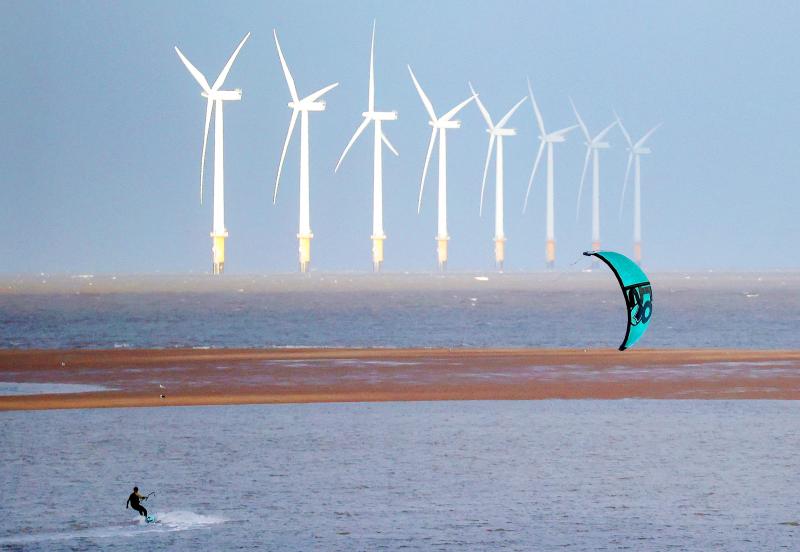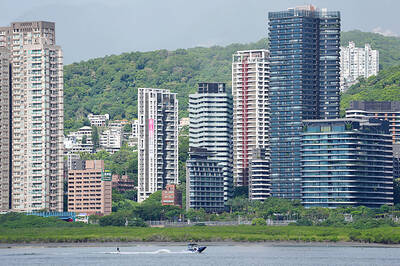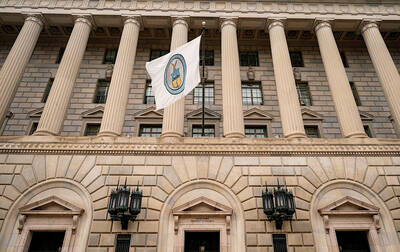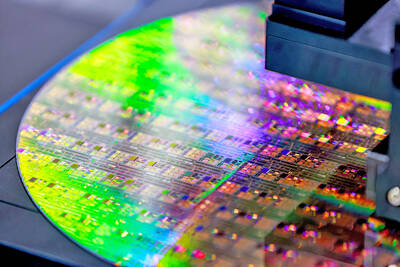Green energy investment is hot again in the US. To some, the new boom would raise the specter of the clean-tech bust that followed a streak of exuberance a decade ago.
However, there are reasons to believe that this time the trend is no bubble or mirage.
In the late 2000s and early 2010s, there was an explosion of investment in clean technology — renewable energy, plus other technologies to reduce carbon emissions.

Photo: Reuters
At first the money came largely from venture capitalists, but then the federal government stepped in and began providing cheap loans and subsidies. Then in 2011, solar manufacturer Solyndra spectacularly failed, causing an immense political backlash.
That was only the most prominent failure; overall, investors lost about US$25 billion when the sector crashed. Money dried up fast. For years, “clean tech” was a dirty word in venture capitalists’ conversations.
However, the worm turns, and clean tech is back.
A venture fund led by billionaire philanthropist Bill Gates — in which Michael Bloomberg, founder of Bloomberg News, also invests — is committing billions of dollars. Funding for battery companies and electric-vehicle companies has skyrocketed, and investment in solar and wind energy dwarfs everything else.
This raises fear of another bubble for some — of history repeating itself. My colleague Liam Denning said that the rapid rise in valuations is a clear indicator of overpricing, which he expects to collapse when interest rates rise. Others see investors repeating the mistakes of a decade ago.
I am more optimistic. Although investors would certainly experience some ups and downs — already the Wilderhill Clean Energy Index has had a major correction since early last month — I am pretty confident that the clean-tech industry as a whole would not experience the kind of bust it did last time.
The most basic reason is that the fundamental underlying technology has matured in a way it simply had not a decade ago.
In 2009, the levelized cost of solar photovoltaic (PV) electricity was US$359 per megawatt-hour — more than four times as expensive as electricity from a natural gas plant.
By 2019, solar PV had fallen in price to US$40 per megawatt-hour, 28 percent cheaper than gas. That is an 89 percent decline in 10 years, with more cost drops yet to come. Meanwhile, lithium-ion batteries have experienced a similar drop in prices.
That order-of-magnitude drop in costs makes all the difference.
First of all, it means that solar and wind are not risky new technologies. Solyndra failed because it was trying to market an innovative new kind of solar cell, which ended up being too expensive when the tried-and-true design came down in cost. Future investments in solar would not have to bet on any difficult technological breakthroughs.
Batteries might be a different story — lots of money is being thrown at start-ups trying to create solid-state batteries, which would be a true breakthrough.
However, Tesla Inc is doing just fine with the old kind, so that sector is probably going to do okay as well. Venture investing does well when it does not have to bet on “hard tech” and much of clean tech is no longer hard.
Second, cost drops in clean energy mean that success does not depend on government intervention. In the earlier boom, fickle government subsidies were often necessary for capital-intensive energy companies to succeed.
Now, even though US President Joe Biden is planning a big push into clean-energy investment, the market is investing quite a lot in renewables all on its own.
Finally, investors have probably learned their lesson. Clean energy itself was never a good fit for venture. It is capital intensive, since buying solar panels and wind turbines entails a lot of money up front; venture capital tends to focus on cheap, small investments that scale. Instead of companies creating highly differentiated products and new markets, as in software, clean electricity companies are basically all trying to provide the same commodified product.
This time around, venture capitalists are letting bigger investors handle the build-out of solar and wind, and finding other niches where low-cost, differentiated start-ups can add value — such as solar services and financing, lab-grown meat and electric vehicles.
Some of those bets are certainly going to fail, but that is always the case in private equity. The success of Tesla — now with a market cap of almost US$700 billion, or 28 times the amount that was lost in the clean-tech bust — demonstrates the time-honored principle that a few big hits can compensate for a lot of little failures.
In other words, clean tech is entering the final stage of the famous Gartner Hype Cycle — a pattern that describes the progression of emerging technologies and business models, starting with an innovation that sees expectations climb and then crash, before they finally rise again to sustained productivity.
The clean-tech bust, like the dot-com bust in 2000, was a case of investor enthusiasm for a new technology outstripping the technology itself.
However, just as few today would question the value of companies like Google and Facebook Inc that came into their own during a trough in investor enthusiasm, eventually the value of clean technology would not be in question.
In Gartner’s terms, we have passed through the Trough of Disillusionment and are now climbing the Slope of Enlightenment.
Noah Smith is a Bloomberg Opinion columnist. He was an assistant professor of finance at Stony Brook University and he blogs at Noahpinion.
This column does not necessarily reflect the opinion of the editorial board or Bloomberg LP and its owners.

Taiwan’s rapidly aging population is fueling a sharp increase in homes occupied solely by elderly people, a trend that is reshaping the nation’s housing market and social fabric, real-estate brokers said yesterday. About 850,000 residences were occupied by elderly people in the first quarter, including 655,000 that housed only one resident, the Ministry of the Interior said. The figures have nearly doubled from a decade earlier, Great Home Realty Co (大家房屋) said, as people aged 65 and older now make up 20.8 percent of the population. “The so-called silver tsunami represents more than just a demographic shift — it could fundamentally redefine the

The US government on Wednesday sanctioned more than two dozen companies in China, Turkey and the United Arab Emirates, including offshoots of a US chip firm, accusing the businesses of providing illicit support to Iran’s military or proxies. The US Department of Commerce included two subsidiaries of US-based chip distributor Arrow Electronics Inc (艾睿電子) on its so-called entity list published on the federal register for facilitating purchases by Iran’s proxies of US tech. Arrow spokesman John Hourigan said that the subsidiaries have been operating in full compliance with US export control regulations and his company is discussing with the US Bureau of

Businesses across the global semiconductor supply chain are bracing themselves for disruptions from an escalating trade war, after China imposed curbs on rare earth mineral exports and the US responded with additional tariffs and restrictions on software sales to the Asian nation. China’s restrictions, the most targeted move yet to limit supplies of rare earth materials, represent the first major attempt by Beijing to exercise long-arm jurisdiction over foreign companies to target the semiconductor industry, threatening to stall the chips powering the artificial intelligence (AI) boom. They prompted US President Donald Trump on Friday to announce that he would impose an additional

Pegatron Corp (和碩), a key assembler of Apple Inc’s iPhones, on Thursday reported a 12.3 percent year-on-year decline in revenue for last quarter to NT$257.86 billion (US$8.44 billion), but it expects revenue to improve in the second half on traditional holiday demand. The fourth quarter is usually the peak season for its communications products, a company official said on condition of anonymity. As Apple released its new iPhone 17 series early last month, sales in the communications segment rose sequentially last month, the official said. Shipments to Apple have been stable and in line with earlier expectations, they said. Pegatron shipped 2.4 million notebook